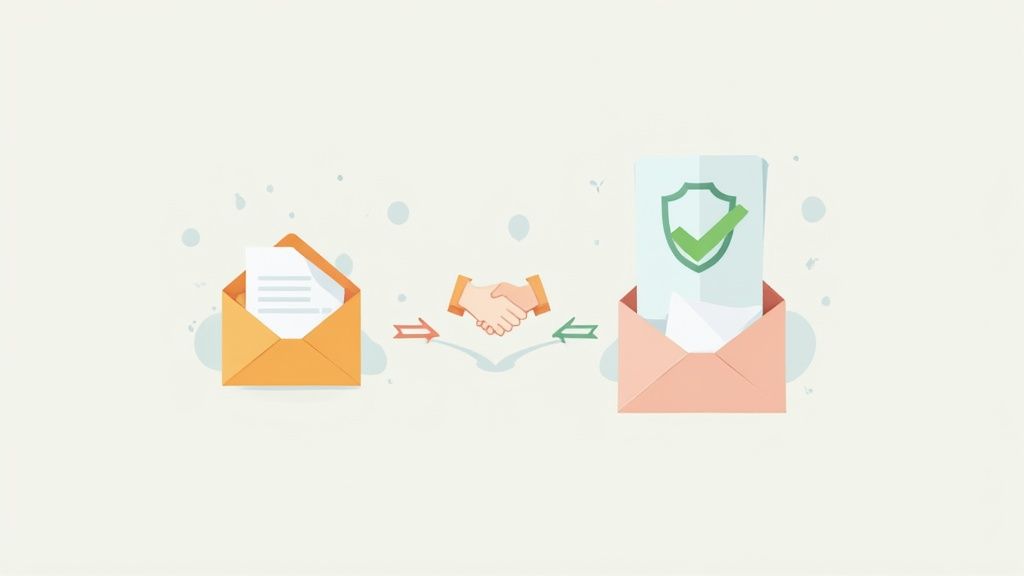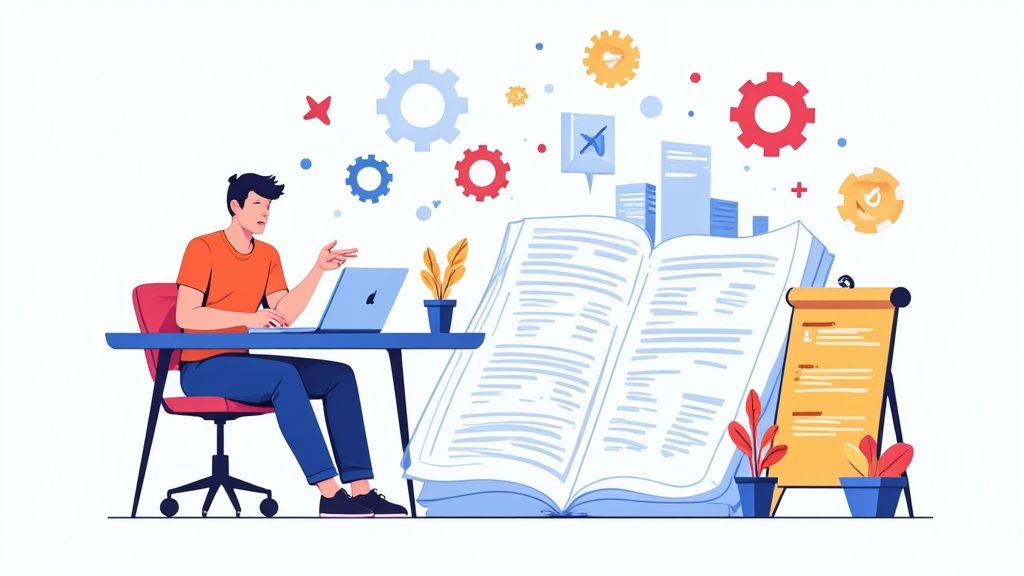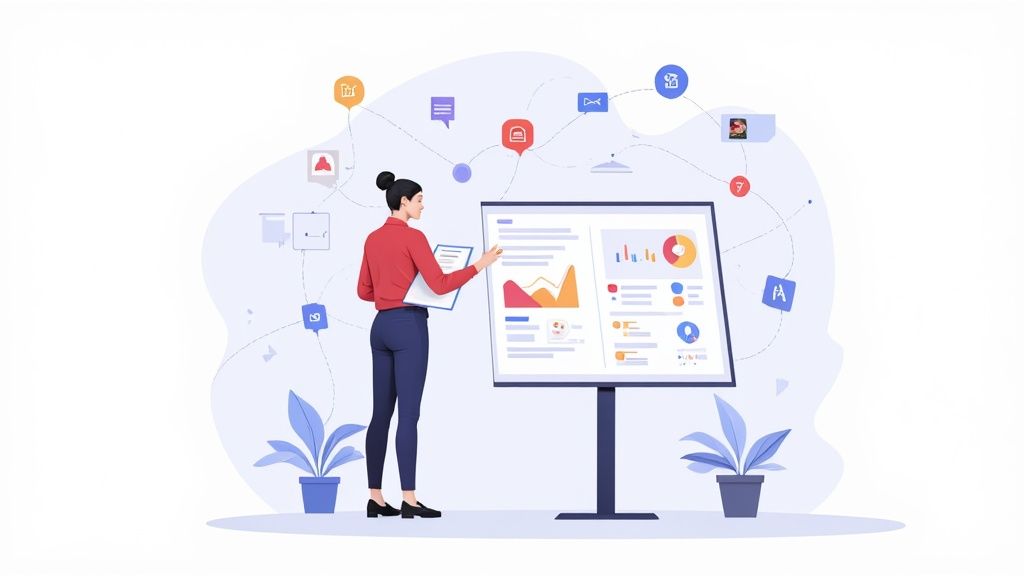Double opt-in is a simple, two-step process. First, a new subscriber enters their email address. Second, they have to click a confirmation link sent to that email to officially join your list.
Think of it as a digital handshake. It's a quick, automated way to verify genuine interest and make sure you’re connecting with real, engaged people, not bots or typos.
Understanding How Double Opt In Really Works
Let's use an analogy. Imagine you're making a new friend. A single opt-in is like getting their phone number. A double opt-in is when they text you first, giving you the green light to connect.
This two-step confirmation is the secret sauce that makes double opt-in such a powerful tool for building a quality email list. It’s not about putting up a barrier; it's about building a foundation of trust right from the start.
This method isn't just a technical detail. It’s a practical way to ensure you're only talking to people who genuinely want to hear from you. The process naturally filters out typos, fake addresses, and spambots, leaving you with a clean list of highly engaged subscribers.
The Subscriber Journey
The journey for a new subscriber is straightforward and transparent. It's designed to confirm they really want to sign up, without being a hassle.
It boils down to three key stages:
- Initial Signup: The user finds your signup form - maybe on a landing page, at the end of a blog post, or during an event registration - and types in their email.
- Confirmation Email: Your system instantly sends an email to that address. This message simply asks them to take one final step to seal the deal.
- Final Confirmation: The user opens that email and clicks the confirmation link. Boom. They're officially on your list.
This simple flow is at the core of what double opt-in is all about.
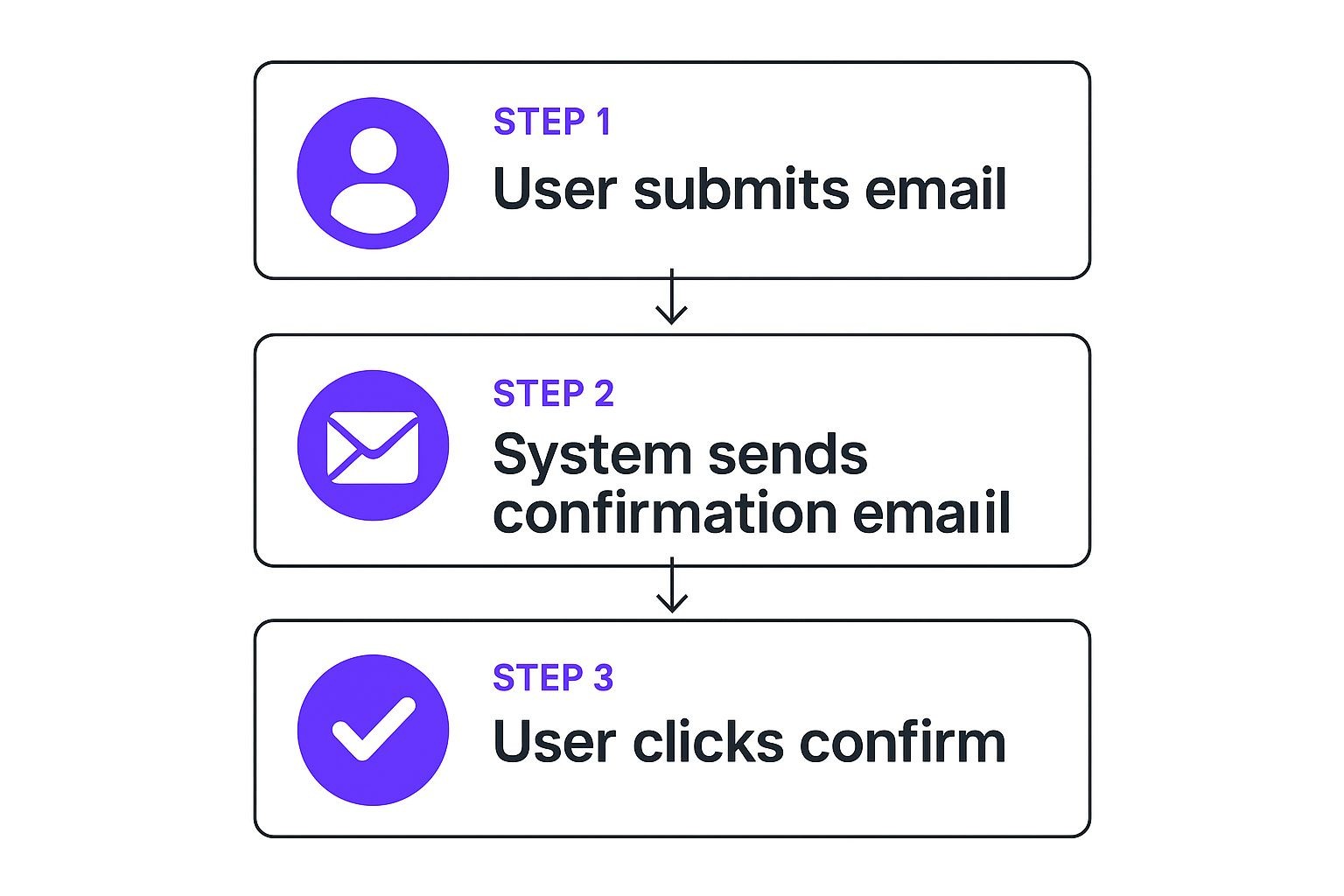
This visual breakdown makes it clear how each step works to verify the subscriber’s identity and interest before you ever send a single marketing message.
Single Opt In vs Double Opt In At a Glance
To really get the difference, it helps to see them side-by-side. Each method has its pros and cons, and the right choice depends entirely on your goals.
| Feature | Single Opt In (SOI) | Double Opt In (DOI) |
|---|---|---|
| Process | One step: User enters email and is instantly subscribed. | Two steps: User enters email, then must click a confirmation link. |
| List Quality | Lower. Prone to typos, fake emails, and bots. | Higher. Verifies each email address and confirms intent. |
| List Growth Speed | Faster. No extra steps mean less friction for signups. | Slower. Some users won't complete the second step. |
| Engagement | Tends to be lower, as interest isn't fully confirmed. | Typically higher, with lower unsubscribe and spam rates. |
| GDPR Compliance | Can be compliant, but proof of consent is harder to document. | Stronger proof of explicit consent, which is great for GDPR. |
While single opt-in can grow your list faster, double opt-in builds a more engaged and valuable audience over the long run.
Why This Process Matters
This verification "handshake" is a favorite among email deliverability experts for a reason. It dramatically cuts down on spam complaints and proves genuine subscriber interest.
Interestingly, the industry is pretty split on which method to use. Recent data shows that about 40% of email marketers use double opt-in, while 47.6% still stick with single opt-in. That two-step consent, however, sends a strong signal to email providers like Gmail and Outlook that you're a reputable sender, which can seriously boost your inbox placement rates.
Ultimately, this method just starts your relationship off on the right foot. It tells subscribers you value their consent and are committed to sending them stuff they actually want. This approach is a cornerstone of any successful strategy, especially when it comes to the world of email marketing for events, where high engagement is everything.
Why Quality Beats Quantity in List Building
When you're starting out in marketing, it's easy to get caught up in chasing big numbers. A huge email list feels like a major win, right? But here's a secret that seasoned pros know well: a smaller, more engaged audience is worth its weight in gold. This is the whole idea behind double opt-in - it shifts your focus from just grabbing email addresses to actually building a real community.
Think about it. When you prioritize quality, you're not just stuffing a name into a database. You're starting a conversation with someone who has literally raised their hand and said, "Yes, I want to hear from you." That confirmed interest is the bedrock of a much stronger, and ultimately more profitable, relationship.
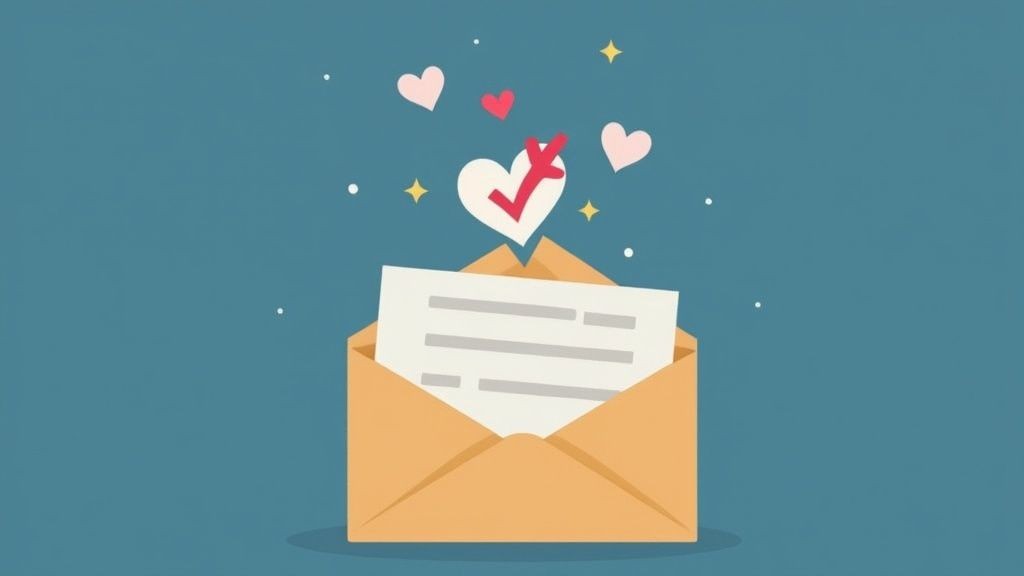
The Real-World Impact on Your Campaigns
Switching to a double opt-in strategy isn't just about good practice; it delivers real, tangible results that go way beyond vanity metrics. The benefits stack up, creating a positive feedback loop that makes your entire email marketing program stronger.
Here’s what that actually looks like:
- Dramatically Improved Deliverability: Ever wonder why some emails hit the inbox while others vanish into spam? It's all about engagement signals. When providers like Gmail and Outlook see that people are opening and clicking your emails, they trust you more. Double opt-in ensures you're sending to valid, interested folks, which tanks your bounce rates and spam complaints - two of the biggest red flags for email providers.
- A Stronger Sender Reputation: Your sender reputation is basically a credit score for your email address. A clean list of confirmed subscribers tells email clients you're a trustworthy sender. The result? Your future campaigns are far more likely to avoid the dreaded spam folder.
- Higher Engagement Metrics: This one's a no-brainer. Subscribers who take the extra step to confirm their email are, by definition, more engaged. They chose to be there. Naturally, they're going to be more likely to open your emails, click your links, and take action.
A smaller, engaged list will always outperform a large, unengaged one. The goal isn't to have the biggest audience; it's to have the right audience that trusts your brand and looks forward to your messages.
A Story of Transformation
Let me tell you about a small e-commerce business I saw go through this. They started with single opt-in, laser-focused on growing their list as fast as possible. They hit 50,000 subscribers and celebrated, but their numbers told a different story: abysmal open rates, a flood of unsubscribes after every send, and a terrible return on investment. They were basically shouting into the void.
Frustrated, they decided to switch to a double opt-in process. At first, it was terrifying. Their list growth slowed to a crawl. But after just three months, everything changed. Their open rates more than doubled, click-through rates tripled, and spam complaints dropped to almost zero. Even though their list was smaller, their campaign ROI shot through the roof because they were finally talking to people who actually wanted to buy their products.
This shift gets to the heart of the matter. The latest data shows the average email open rate has climbed to 37.27%, with an estimated ROI of $36 to $42 for every $1 spent. Email is still an absolute powerhouse, but only if it reaches an engaged audience. Double opt-in is your best defense, minimizing bounces and spam reports to make sure your messages connect with the 51% of consumers who prefer hearing from brands via email. If you want to dive deeper into the numbers, check out these crucial email marketing statistics.
Staying on the Right Side of Privacy Laws with Double Opt-In
In a world where data privacy is king, double opt-in isn't just a "nice-to-have" - it's your best defense against legal headaches.
At its core, the process is simple: a user fills out your form, then gets an email with a confirmation link they have to click. That second click creates an undeniable, timestamped record of their consent.
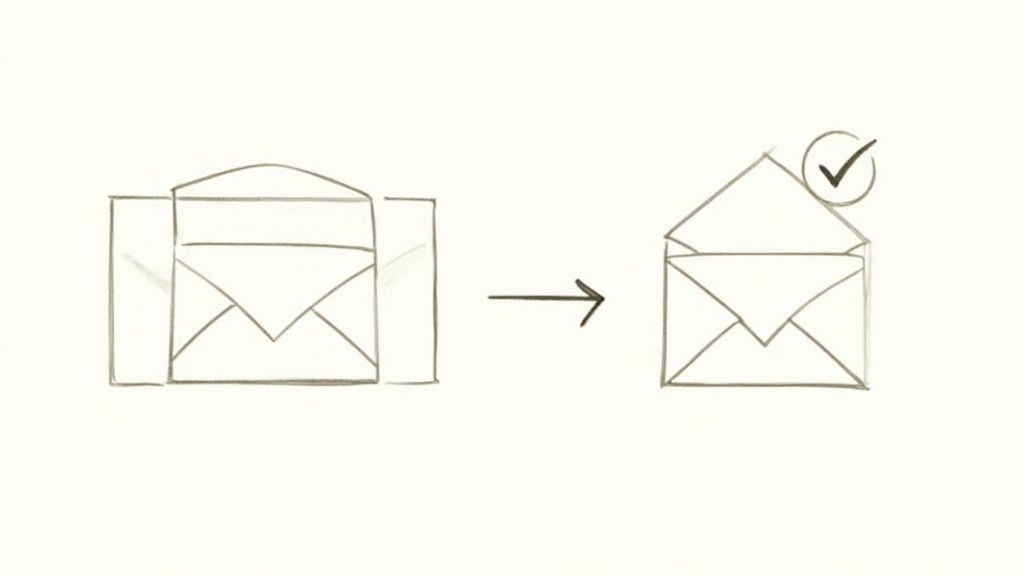
Major regulations like GDPR and the California Consumer Privacy Act (CCPA) have completely changed the game, demanding explicit consent for any kind of email marketing.
Now, while these laws don't come right out and say "you must use double opt-in," they do require that consent is clear, informed, and provable. Double opt-in just happens to be the most straightforward way to tick all those boxes.
Key Privacy Regulations
Under GDPR, you have to collect user consent in a way that’s completely unambiguous and specific. No more pre-checked boxes or vague language.
Meanwhile, CCPA is all about giving consumers power over their personal data - the right to know what you have, to delete it, or to opt out of its use.
"Clear consent is at the heart of trust and compliance."
This is where having a solid audit trail becomes your compliance insurance policy. You need to keep detailed records of who consented, when, and how, just in case regulators come knocking.
Think of it this way. Double opt-in gives you:
- Explicit Consent: That second click is a clear "Yes, I want this."
- A Timestamped Record: You know exactly when and how they signed up.
- Fewer Disputes: A clear audit trail protects your business from complaints.
- Support for User Rights: It’s much easier to handle data requests when you have clean records.
Imagine an event organizer in Europe facing a GDPR audit. With double opt-in, they can pull up the exact consent logs for every single subscriber. That's powerful stuff. This same clarity helps you stay clear of complaints under CCPA and other similar laws.
Ultimately, using double opt-in sends a powerful message: you respect your users' privacy.
The Big Wins of Using Double Opt-In
Switching to a double opt-in process isn't just about playing defense. It comes with some serious advantages for your business and reputation.
For starters, you immediately cut down on fake or misspelled email addresses. This slashes your bounce rates and dramatically reduces spam complaints.
When email providers like Gmail see lower bounce and complaint rates, they see your emails as wanted and are more likely to deliver them to the inbox. It's a win-win.
- Strengthens Trust: When people take that extra step to confirm, they're already more engaged and invested in what you have to say.
- Lowers Legal Risks: An auditable consent record is your shield against potential fines and legal battles.
- Improves Deliverability: A cleaner, higher-quality list leads to better inbox placement. Simple as that.
- Enhances Brand Image: Showing you respect privacy from day one builds the kind of loyalty that lasts.
Even when it’s not strictly required, double opt-in is a best practice that aligns perfectly with the spirit of GDPR and CCPA.
For a deeper dive, check out our guide on GDPR compliance for websites.
By linking your consent management directly to double opt-in, our service helps streamline your compliance efforts, protecting both your team and your subscribers.
How Double Opt-In Builds Real Trust
Let's be clear: double opt-in is about more than just avoiding fines.
It’s a signal to your new subscriber that you value their choice and respect their inbox. That extra step, that small moment of confirmation, positions your brand as transparent and trustworthy right from the very first interaction.
That kind of trust is what drives real engagement, boosts open rates, and turns subscribers into loyal fans.
In the next section, we’ll explore how to choose the right opt-in strategy for your business.
So, Which Opt-In Strategy Is Right for Your Business?
Double opt-in is a fantastic tool for building a high-quality, engaged email list, but let's be real - it's not a one-size-fits-all solution. The best strategy really comes down to your business model, your industry, and what you’re trying to achieve with a specific campaign.
Choosing between single and double opt-in means weighing the trade-offs. Are you after rapid list growth, or are you playing the long game for subscriber value?
For some businesses, the choice is pretty clear. If you're in an industry that depends on building long-term trust and delivering high-value content - think finance, SaaS, or publishing - double opt-in is almost always the way to go. It makes sure every single subscriber is genuinely invested, which is what matters when your success is tied to sustained engagement, not just a flashy signup number.
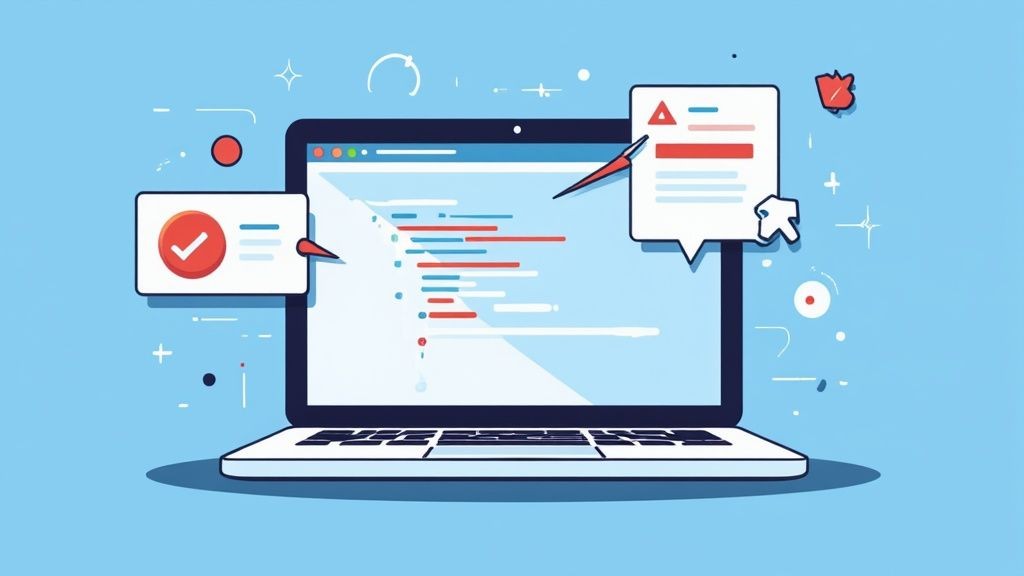
When to Go for Quality with Double Opt-In
Some situations just scream for the meticulous approach of double opt-in. If your marketing is all about nurturing leads over time, this method is your best friend.
You should seriously consider double opt-in if you are:
- Building a Newsletter Community: For a weekly or monthly newsletter, engagement is everything. You want readers who actually look forward to your content, not just passive subscribers who do nothing but inflate your numbers.
- Hosting Webinars or Events: For events, a confirmed list means more reliable attendance figures and way fewer no-shows. Our service, Add to Calendar PRO, integrates perfectly with this approach to ensure your event communications hit the inboxes of people who are truly interested.
- Operating in a Regulated Industry: In sectors like finance or healthcare, proving you have explicit consent isn't just a good idea - it's non-negotiable. Double opt-in gives you that clear audit trail you need for compliance and to minimize risk.
When Speed Might Beat Perfection
On the flip side, some business models are built for speed and volume, making single opt-in a really tempting choice. E-commerce and retail businesses, for instance, often use it to quickly capture leads during a flash sale or a time-sensitive promotion. The goal is to slash friction and get an offer in front of as many people as possible, as fast as possible.
But that speed comes with a cost, usually in the form of higher bounce rates and lower engagement down the line. The industry data tells this story pretty clearly.
While only 9.19% of campaigns use double opt-in overall, the publishing sector leads the pack with 26.64% adoption. In stark contrast, retail marketers show the lowest usage at just 3.06%, preferring the quick list growth of single opt-in for their big promotional pushes. If you want to dive deeper, you can check out more of these email marketing trends and statistics.
Putting Double Opt-In to Work for Your Events
Knowing the theory is one thing, but actually using double opt-in for your events is where you'll see the magic happen. The real goal here isn't just to collect signups - it's to build a list of people who are genuinely fired up to attend. This is a game-changer for event marketing, where engagement is everything.
At our company, we designed this whole process to be dead simple inside our service, Add to Calendar PRO. You can flip on double opt-in and make sure every single person who registers for your webinar, conference, or community hangout has explicitly confirmed they want to be there. In one move, your RSVP list transforms from a random collection of emails into a hand-picked audience of qualified participants.
Building Your Confirmed Attendee List
You don't need a technical background to get double opt-in running for your events. We built the entire flow to be intuitive, letting you create a secure and compliant registration process in just a couple of clicks. It's the first step to slashing no-shows and making sure your emails actually land in the inbox.
Here’s a quick peek at how easy it is to manage this from our dashboard.
From here, you can jump straight into your event’s RSVP settings and enable the double opt-in feature. You’re in complete control.
This simple, hands-on approach helps you build a better event experience right from the first hello. When people take that extra step to confirm, you can be confident that your reminders, updates, and pre-event content are going to an audience that's actually listening.
How Double Opt-In Supercharges Your Event Marketing
Requiring a two-step confirmation does more than just clean up your email list; it tackles some of the biggest headaches event organizers deal with. When you know every registrant is real and interested, it sets off a chain reaction of good things.
- Slash Your No-Show Rates: When someone confirms, they're making a small psychological commitment. That extra click is a conscious "yes," making them far more likely to actually show up on the day.
- Boost Your Email Deliverability: Sending emails to a verified list keeps your bounce rate way down. This is a huge signal to providers like Gmail and Outlook that you're a trustworthy sender, helping your important updates avoid the dreaded spam folder.
- Create a High-Quality Audience: Your attendee list suddenly becomes a serious asset. These are people who raised their hands and said, "I'm in!" - making them perfect for future events, newsletters, or community-building efforts.
For an event organizer, a double opt-in list is the difference between shouting into a crowd and having a conversation with a dedicated audience. It guarantees everyone on your list wants to be there, which leads to a more vibrant, interactive experience for everybody.
Ultimately, this process builds a solid foundation of trust with your audience from day one. If you want to dive in, you can learn more about how to create an RSVP link with all these powerful features baked right in.
Answering Your Top Questions About Double Opt-in
Even after you've got the basics down, you might still be wondering about the real-world impact of using double opt-in. It's a common feeling. Let's tackle the biggest questions and concerns marketers have, so you can make the right call for your own strategy.
We’ll clear up the confusion, talk about compliance, and give you a few tips to make it work even better for you.
Will Double Opt-in Kill My List Growth?
This is the big one, isn't it? The honest answer is that yes, it can slow down the speed at which your list grows. But that's not the whole story, and it's definitely not a bad thing. This process is designed to add a little friction, filtering out the casual sign-ups and keeping only the people who are genuinely interested.
Think of it like this: a single opt-in list might balloon quickly, but it’s often full of fluff - typos, unengaged contacts, maybe even a few spambots. Over time, that low-quality list will drag down your sender reputation and hurt your ability to even land in the inbox.
A smaller, highly-engaged list built with double opt-in will almost always beat a larger, unengaged one. It’s the classic quality over quantity debate, and when it comes to email, quality wins every single time.
Is Double Opt-in Actually a Legal Requirement?
It’s a common misconception, but no, double opt-in is not explicitly required by major privacy laws like GDPR or the CCPA. What those laws do demand is clear, undeniable, and provable consent. They just don't tell you exactly how to get it.
So why is double opt-in considered the gold standard? Because it automatically creates a perfect, timestamped paper trail. You have undeniable proof that the owner of that email address clicked a link to confirm they wanted to hear from you. It’s the strongest, most defensible form of consent you can have, making it a fantastic insurance policy against any future complaints.
How Can I Get More People to Confirm?
It's totally normal to lose a few potential subscribers at the confirmation step. The goal isn't to get a 100% confirmation rate, but to make sure that number is as high as it can be. The secret is to treat your confirmation email like a genuine, positive touchpoint with your brand, not just a technicality.
Here are a few simple things you can do to boost those confirmation rates:
- Tell them what's next: On your signup form, add a simple heads-up. Something like, "Great! Now check your inbox to confirm your spot." can make a world of difference.
- Write like a human: Ditch the generic template. Your confirmation email should sound like you. Use a clear, action-oriented subject line like, "Just one more step to get your event tips!" and keep the email itself short and sweet, focused on getting that click.
- Remind them of the "why": Give them a quick refresher on why they signed up in the first place. A simple line like, "Confirm your subscription to get the weekly event marketing insights you wanted," reinforces the value.
- Keep it on-brand: Make sure the email looks and feels like it came from you. Using your logo, brand colors, and fonts builds trust and makes the whole experience feel seamless and professional.
By putting a little thought into this one crucial email, you can make sure you're starting every new subscriber relationship on the best possible footing.
At Add to Calendar PRO, we built double opt-in right into our event RSVP system. It’s a dead-simple way to build a high-quality, confirmed list of attendees for your events. See how we can help you boost engagement and stay compliant at https://add-to-calendar-pro.com.
